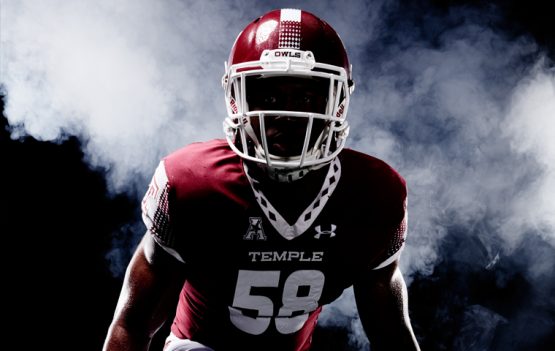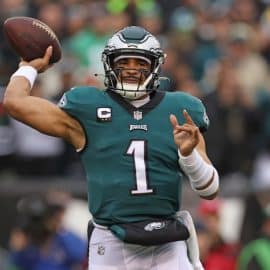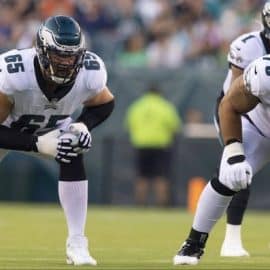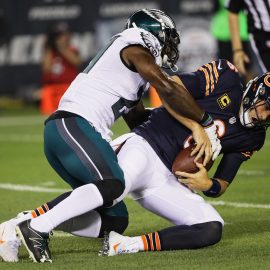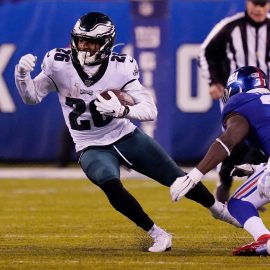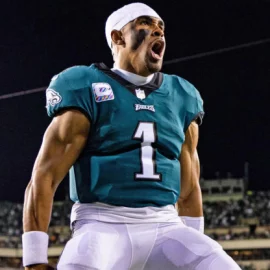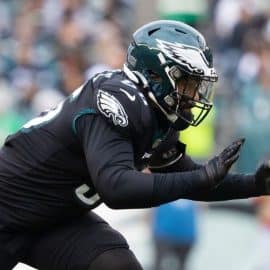It didn’t start with Carmichael. For many decades, guys who were “too tall” didn’t get a second look in Eagles or Phillies scouting circles. Gene Conley at 6-8 was an exception as a pitcher for the Phils in 1959 and 1960, but he had already proven his worth with the Boston/Milwaukee Braves, so his case was an outlier.
The prevailing thought for a long time (since the early 1900’s) was tall guys were too slow and lacked sufficient coordination for the quick-twitch demands of football and baseball. Anyone taller than 6-3 was steered toward basketball and track.
The neanderthal thinking was tall guys were more prone to injury, and slower to react to football decision-making on the field of play. Personnel folks wanted that 5-10 to 6-2 guy, thick in the right places, guys who looked fast with short strides.
Wilt Chamberlain at 7-1, 265, once offered his professional services to the Eagles at tight end back in 1965. The Eagles declined the offer.
Was that “height bias” or simply economics? I guess we’ll never know. Maybe both.
Enter Harold Carmichael, draft prospect, 6-8, 225, who had attended William M. Raines High School in Jacksonville, Florida, where he played the clarinet in the school’s band. He also played quarterback on the football team.
He walked-on at Southern University and became a tri-sport athlete. He used his 6’8″ height to play on the basketball team as a center, and threw the javelin and discus for the track and field team. In football, he shifted to playing wide receiver, where he was a four year starter, although he never led the team in receptions. He received All-conference honors as a senior. He was a teammate of Mel Blount.
Carmichael was selected by the Philadelphia Eagles in the seventh round (161st overall) of the 1971 NFL Draft. As a rookie, he was converted into a tight end, starting in 6 out of the 9 games that year and leading the team’s tight ends with 20 receptions (fourth overall on the team).
The next year he was moved to wide receiver. In 1973, he had a breakout year with the arrival of head coach Mike McCormack, leading the league with 67 receptions for 1,116 yards (16.7-yard average) and was tied for fourth with 9 receiving TD’s.
He ended his career with 590 receptions for 8,985 yards with 79 career touchdown catches, along with 64 rushing yards on nine carries. He currently ranks 25th all-time in career touchdown receptions, but he was 7th all-time at the time of his retirement. His career catches ranked fifth all-time when he retired. He retired as the Eagles’ all-time leader in pass receptions, receiving yards, receiving touchdowns, and total touchdowns (79), with all four records still standing as of early 2017. He also holds Eagles post-season records for receiving yards (465), touchdowns (6), yards per reception (16.0), and yards per game (66.4). He and Brent Celek are the only Eagles with 3 touchdowns in a single post-season (1979), and he is one of four players with 2 touchdowns in a single post-season game. He holds the Eagles record for most games with a touchdown for both the regular season (69) and playoffs (5, shared with Duce Staley and Brian Westbrook). At 6 foot 8 inches, he is believed to be the tallest wide receiver in the history of the NFL.
Ray Didinger was there when Carmichael was drafted:
“It was the seventh round of the 1971 NFL Draft. At that point, there was no ESPN and no one had heard of Mel Kiper, Jr. The NFL Draft was not the media colossus that it is today.
“As a reporter covering the draft for the Philadelphia Bulletin, I was in the press room at Veterans Stadium when Jim Gallagher, the Eagles’ publicity director, came through distributing one-page bios on the team’s latest draft pick. It was some kid named Harold Carmichael.
“I glanced at the sheet and immediately saw what appeared to be a mistake.
“Hey, Jim,” I said. “This has to be wrong. It says here this guy is 6-foot-8.”
“That’s what they told us,” Jim said. “I called the school just to be sure. They said he’s 6-8.”
“It sounded crazy. A 6-8 receiver? And he’s a seventh-round draft pick? The 161st selection overall? It seemed unlikely. And given the Eagles’ history in recent drafts, it didn’t come with great expectations.”
A few days later, Carmichael walked onto the Veterans Stadium turf for the first time and jaws dropped. He was every bit of 6-8 and, amazingly enough, he could actually run and catch. OK, Ray Diddy thought, maybe he will make the team after all.
Now he is a member of the Pro Football Hall of Fame.
An interesting footnote to Carmichael’s selection: The last two Eagles voted into the Hall of Fame (Carmichael and Brian Dawkins) are both graduates of William M. Raines High School in Jacksonville, Florida. Lito Sheppard, the Pro Bowl cornerback, also went to that school. Note to executive vice president/general manager Howie Roseman: You might want to start scouting more games at William Raines High.
In addition to his record-setting career on the field, Carmichael worked for the organization for 20 years as director of player development and alumni affairs. He was always there, towering over the crowd, as a symbol of what it meant to be a Philadelphia Eagle. He was voted NFL Man of the Year in 1980 and he is still very active in the community even in retirement.
“I was born and raised in Jacksonville,” he told the crowd last night, “but this is home for me. I love the people in Philadelphia.”
For me personally, it was a TV/radio relationship with Harold, although I saw him play in person a few times whenever I could score a free ticket. Don Pardo saw him in person when he set a team and NFL receiving record. I just remember cringing every time he took a major hit on that hard Vet turf, and being amazed when he got up and did it again. You see, I was an unwitting sheep follower of the “too tall” doctrine. Harold proved us all wrong.
Receiving:
| Year | Team | No. | Yds | Avg. | Long | TDs |
|---|---|---|---|---|---|---|
| 1971 | NFL Philadelphia Eagles | 20 | 288 | 14.4 | 50 | 0 |
| 1972 | NFL Philadelphia Eagles | 20 | 276 | 13.8 | 54 | 2 |
| 1973 | NFL Philadelphia Eagles | 67 | 1116 | 16.7 | 73 | 9 |
| 1974 | NFL Philadelphia Eagles | 56 | 649 | 11.6 | 39 | 8 |
| 1975 | NFL Philadelphia Eagles | 49 | 639 | 13.0 | 62 | 7 |
| 1976 | NFL Philadelphia Eagles | 42 | 503 | 12.0 | 24 | 5 |
| 1977 | NFL Philadelphia Eagles | 46 | 665 | 14.5 | 50 | 7 |
| 1978 | NFL Philadelphia Eagles | 55 | 1072 | 19.5 | 56 | 8 |
| 1979 | NFL Philadelphia Eagles | 52 | 872 | 16.8 | 50 | 11 |
| 1980 | NFL Philadelphia Eagles | 48 | 815 | 17.0 | 56 | 9 |
| 1981 | NFL Philadelphia Eagles | 61 | 1028 | 16.9 | 85 | 6 |
| 1982 | NFL Philadelphia Eagles | 35 | 540 | 15.4 | 46 | 4 |
| 1983 | NFL Philadelphia Eagles | 38 | 515 | 13.6 | 35 | 3 |
| 1984 | NFL Dallas Cowboys | 1 | 7 | 7.0 | 7 | 0 |
| Totals | 590 | 8985 | 15.2 | 85 | 79 |
Add The Sports Daily to your Google News Feed!

